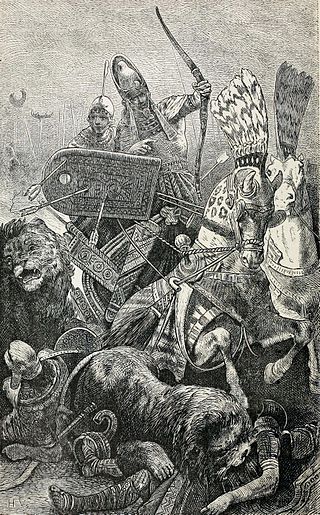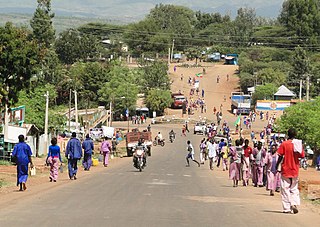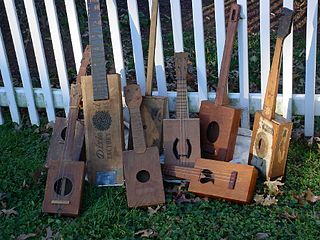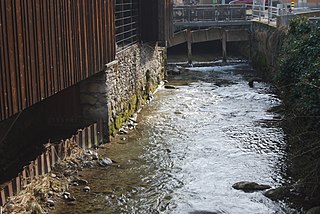
A cigar is a rolled bundle of dried and fermented tobacco leaves made to be smoked. Cigars are produced in a variety of sizes and shapes. Since the 20th century, almost all cigars are made of three distinct components: the filler, the binder leaf which holds the filler together, and a wrapper leaf, which is often the highest quality leaf used. Often there will be a cigar band printed with the cigar manufacturer's logo. Modern cigars often come with two bands, especially Cuban cigar bands, showing Limited Edition bands displaying the year of production.

Marodi Jeh is an administrative region (gobol) in western Somaliland. It is the most populous region of the country. It is bordered by Awdal to the west, Sahil to the north, Togdheer to the east and Ethiopia to the south. Marodi Jeh was created by splitting the previously existing region (gobolka) Woqooyi Galbeed in two, the other part being Sahil. In 2007 the region of Woqooyi Galbeed was renamed to Maroodi Jeex. Woqooyi Galbeed was thus much larger than Marodi Jeh.

Lalibela is a town in the Amhara Region of Ethiopia. Located in the Lasta district and North Wollo Zone, it is a tourist site for its famous rock-cut monolithic churches. The whole of Lalibela is a large and important site for the antiquity, medieval, and post-medieval civilization of Ethiopia. To Christians, Lalibela is one of Ethiopia's holiest cities, and a center of pilgrimage.
Lector is Latin for one who reads, whether aloud or not. In modern languages it takes various forms, as either a development or a loan, such as French: lecteur, English: lector, Polish: lektor and Russian: лектор. It has various specialized uses.

Sesostris, also transliterated as Sesoösis, or Sesonchosis, is the name of a legendary king of ancient Egypt who, according to Herodotus, led a military expedition into parts of Europe. Tales of Sesostris are probably based on the life of Senusret I, Senusret III and perhaps other Pharaohs such as Sheshonq I and Ramesses II.

Wollo was a historical province of northern Ethiopia that overlayed part of the present day Amhara, Afar, and Tigray regions. During the Middle Ages this region was known as Bete Amhara and had Amhara kings. Bete Amhara had an illustrious place in Ethiopian political and cultural history. It was the center of the Solomonic Dynasty established by Emperor Yekuno Amlak around Lake Hayq in 1270, the original center of Amhara people, whose territorial reach extended from Lake Hayq and the Beshillo River in the north, the Afar and Argobba lowlands in the east, the Abbay River in the West, and the Awash River just south of modern Addis Ababa.

Konso is a town on the Sagan River in south-western Ethiopia. The administrative center of the Konso special woreda of the Southern Nations, Nationalities, and Peoples Region, this town has a latitude and longitude of 5°15′N37°29′E and an elevation of 1650 meters. It is also called Pakawle by some of the neighboring inhabitants. The town and the surrounding villages were inscribed on the UNESCO World Heritage List in 2011 as a cultural landscape for its unique cultural traditions and importance for the Konso people.

The cigar box guitar is a simple chordophone that uses an empty cigar box as a resonator. The earliest had one or two strings; modern models typically have three or more. Generally, the strings are connected to the end of a broomstick or a 1×2 inch wood slat and to the cigar box resonator.

Rock-cut architecture is the creation of structures, buildings, and sculptures by excavating solid rock where it naturally occurs. Intensely laborious when using ancient tools and methods, rock-cut architecture was presumably combined with quarrying the rock for use elsewhere. Though, in India and China, the terms cave and cavern are often applied to this form of man-made architecture, caves and caverns that began in natural form are not considered to be rock-cut architecture even if extensively modified. Although rock-cut structures differ from traditionally built structures in many ways, many rock-cut structures are made to replicate the facade or interior of traditional architectural forms. Interiors were usually carved out by starting at the roof of the planned space and then working downward. This technique prevents stones falling on workers below. The three main uses of rock-cut architecture were temples, tombs, and cave dwellings.

Lalibela, regnal name Gebre Meskel, was a king of the Zagwe dynasty, reigning from 1181 to 1221. According to Taddesse Tamrat, he was the son of Jan Seyum and brother of Kedus Harbe. Perhaps the best-known Zagwe monarch, he is credited as the patron of the namesake monolithic rock-hewn churches of Lalibela. He is venerated as a saint by the Ethiopian Orthodox Tewahedo Church on 19 June.

The cigar store Indian or wooden Indian is an advertisement figure, in the likeness of a Native American, used to represent tobacconists. The figures are often three-dimensional wooden sculptures several feet tall – up to life-sized. They are still occasionally used for their original advertising purpose, but are more often seen as decorations or advertising collectibles, with some pieces selling for hundreds of thousands of dollars.

WAGA-TV is a television station in Atlanta, Georgia, United States, serving as the market's Fox network outlet. Owned and operated by the network's Fox Television Stations division, the station maintains studios and transmitter facilities on Briarcliff Road Northeast in the Druid Hills area of unincorporated DeKalb County, just outside the Atlanta city limits.

The architecture of Ethiopia varies greatly from region to region. Over the years, it has incorporated various architectural styles and techniques.

Delbert Lee "Cigar" Daisey, known as "Cigar" Daisey, was an American waterfowl wood carver and decoy maker. He was the son of Herbert Lee Daisey and Emma Jane Daisey. He was born, lived and worked in Chincoteague, Virginia, and was the resident carver at the Refuge Waterfowl Museum. His decoy carvings are recognized for both their artistic value and functionality as working pieces for waterfowl hunting. His works include black ducks, mallards, redheads, ruddys and red-breasted mergansers and often crafted in drake (male) and hen (female) pairs. He had carved about 1900 ducks in total and he generally used cork or wood as his medium. He carved his first duck out of balsa wood in 1940 at his father's wood shop. The Smithsonian has his works in their collection. He was given his nickname in 1945 by John Buckalew, Federal Game Warden and first manager of the Chincoteague National Wildlife Refuge because Daisey would leave cigar butts to taunt game wardens while poaching ducks on Assateague Island. Later in life, Daisey was an avid conservationist.

The Wyna is a river located mostly in canton of Aargau, but also in canton of Lucerne, Switzerland and runs through the Wynetal. It is a tributary of the Suhre. The Wyna is 32 km long. Larger towns in Wynetal are Beromünster, Menziken, Reinach (AG) and Gränichen.

The Konso, also known as the Xonsita, are a Lowland East Cushitic-speaking ethnic group primarily inhabiting south-western Ethiopia.
Waga Hip Hop is one of the major international hip hop festivals taking place in West Africa. Each year, around early and mid-October, Ouagadougou thus welcomes international artists and media to attend this festival of urban cultures.
Waga is a town in Sri Lanka.

Holland House was a New York City hotel located at 274–276 Fifth Avenue at the southwest corner of 30th Street in NoMad, Manhattan, New York City, with a frontage of 250 feet (76 m) on Fifth Avenue. The architects and designers were George Edward Harding & Gooch. A mercantile building by the 1920s, in the present day, it is a loft building.

The Jile, also known as a Gile in Afar language, in Somali known as Qolxad, is a type of dagger with a long curved blade used by the Somali and Afar people found in Djibouti, Ethiopia, Somalia, and Eritrea. Unique to the Horn of Africa, it is the most famous and characteristic of Afar and Somali daggers.
















